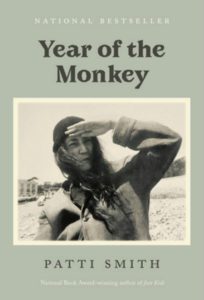
I was lured away by the sound of peculiar birds, big squawky ones, standing at attention and right on the verge of speaking. Unfortunately, a small part of me was debating whether birds could actually speak, which broke the connection. I circled back, questioning myself why I had regrettably hesitated when I am well aware that certain winged creatures possess the ability to form words, spin monologues and at times dominate an entire conversation.
A punk icon, Rock & Roll Hall of Fame inductee, best-selling author, and National Book Award winner, Patti Smith redefines memoir by way of seamlessly merging dreamscape, external circumstance, perception, imagination, and intuition. Smith invites us to convene in the cavity of her skull, peer out from the windows of her mind, sit in suspended disbelief while she illustrates a vibrating world of interconnectivity, vast dimensional literacy, startling and miraculous synchronicity, and an incredible reverence for all things. She does not defend or apologize for her world, nor does she assume her reader is unfamiliar with it. Instead we are casually gifted an opportunity to see earth as we know it sparkling with the magic of Smith’s creative, spontaneous, and flexible mind.
The medicinal smells and rubber-soled entrances of the nurses with clipboards and plastic bags of fluids unnerved me as I sat beside desperately searching for a way in, some connective channel… I found myself projecting constellations of words on his white sheets, an endless jumble of phrases streaming from mouths of miraculous totems lining an inaccessible horizon… What do you make of it, Sandy? I prodded silently. Machines pulsing. Saline solution dripping. Sandy squeezed my hand but the nurse said it didn’t mean anything.
Written in the first person, Year of the Monkey chronicles Smith’s life in 2016, beginning on a melancholy New Year’s Day, a day normally spent with a dear friend, Sandy, who is now comatose in a Marin County ICU after abruptly collapsing in a parking lot. And though Sandy’s grave state is a continuous point of return throughout this book, structuring and giving context to Smith’s year, it would be a vast diminishment to call it the plot. Instead I might say this is a book about black coffee, green onions, waterside cafes, and adventuring in quiet and instinctive ways.
But in all Smith’s gratitude and lust is an ability for great sorrow and bereavement. Smith visits Sam Shepard twice in this book, writing of their time together amid his rapidly progressing ALS and increasing immobility. She grieves on anniversaries and birthdays, panging with devotional veneration and memories of her deceased parents, brother, friends and late husband, Fred “Sonic” Smith. At moments this book takes on a chaotic deconstruction, depicting horrific storms, leaking skylights, whiplashed daffodils, insomnia, Donald Trump’s presidential campaign and electoral college victory, environmental distress and isolation over tins of sardines and countless iterations of eggs. Still, Smith’s sadness does not serve to disintegrate her zeal for living. It only helps to dictate the piers off of which she dives, never scraping anything less than the deepest, most fertile surface she can access.
Readers might at first be alarmed by the hazy quality between passages of this book, its unmarked boundaries between time, dreamscape, imagination, metaphysical pursuit, and life outside of Smith’s mind and perception. One might feel startled when the motel sign begins “chiding” Patti, or confused by the apparent telepathy between her and those like-hearted. But to surrender to the universe of this book is to experience a microcosm that effortlessly and relentlessly breathes with sentience, bewilderment, prayer, and magic. In this book we can begin to understand that the experience of living does not have to be confined to the external, to the quantifiable or the visible. Instead, Smith seems to softly and constantly assert that to experience life in all of its precious and profound qualities, one must often communicate outside of the intellect: “—Some dreams aren’t dreams at all, just another angle of physical reality.”
From the first pages of this book until its completion, Patti is invested in planning a visit to Ayers Rock in Australia. Her hands, however, never touch the red dust of Uluru, an image that returns like a lilting motif throughout, rearing its quiet head in darkened doors, a shadowy theme silently organizing the narrative. Somehow the presence of this trip never taken is as real and influential as any connective tissue in the book. This is one of many examples of how Smith’s memoir ceaselessly begs the question, At what points of contact with the world around us do we experience Life? This question repeats itself frequently and discreetly, in unsuspecting corners of poignance, memory, fear, sadness, enthusiasm and longing. “You don’t see things like that. You feel them, as in all important things; they arrive, they come into your dreams.”
To be able to put everything about this memoir into a short review would be something like pushing a universe through a keyhole. The range of human experience captured in Year of the Monkey honors the nuance, complexity, and the often paradoxical nature of being a person on earth. To put it simply, Patti cares. About all of it. And in caring about the world, she loves it despite its pain, nurtures it with the will to heal, encourages it to fly, and urges it into the world with faith that dreaming is not in vain.
“This is what I know—Sam is dead. My brother is dead. My mother is dead. My father is dead. My husband is dead. My cat is dead. My dog, who was dead in 1957, is still dead. Yet still I keep thinking that something wonderful is about to happen. Maybe tomorrow.”




